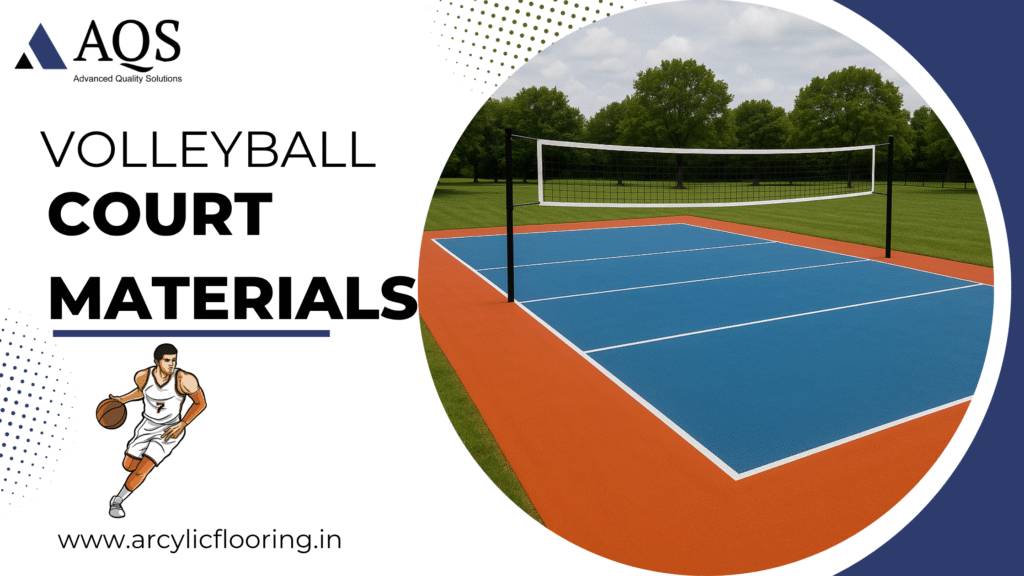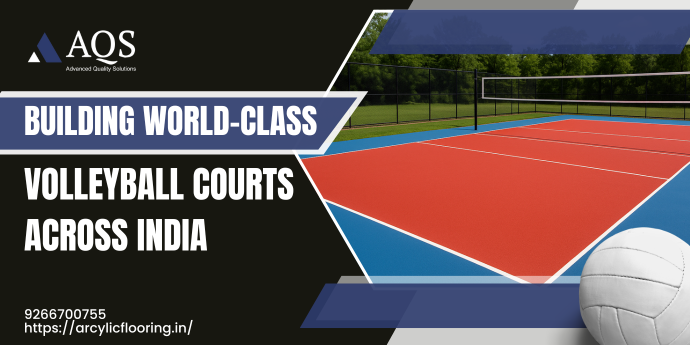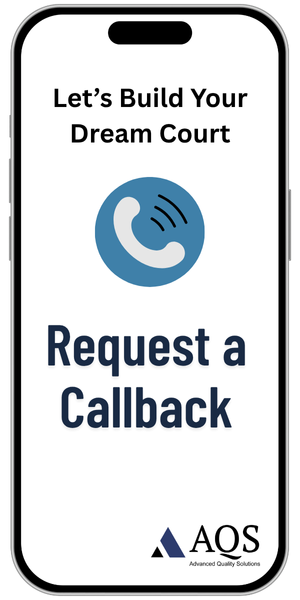In Indian schools, colleges, residential complexes and sports academies, volleyball has become a popular sport. The demand for high performance, long lasting and safe volleyball court flooring has never been higher as more players are moving to this exciting and fast sport. The right flooring is crucial for safety, reducing injuries and improving gameplay especially on outdoor volleyball courts.
At AQS, we manufacture and supply premium synthetic acrylic volleyball court flooring suitable for Indian climate and usage pattern. In this article we will cover everything you need to know about volleyball court construction, right volleyball court flooring material, size regulations, surface types, color options and choosing the best volleyball court contractors in India.
Understanding Volleyball Court Standards in India
Before you choose flooring, it’s important to understand the basic structure and measurements of a volleyball court. This is the foundation, as everything else depends on this.
Standard Volleyball Court Size in India
The official volleyball court size in India is the same as global FIVB regulations. These dimensions are for professional matches and also the base standards for school and recreational courts.
- Length: 18 meters
- Width: 9 meters
- Free Zone: A minimum of 3 meters on all sides to ensure player safety
- Clear Height: A minimum of 7 meters from the surface for unobstructed play
Accurate dimensions give players a consistent experience and help prevent disqualification during tournaments. Court layout and drainage system alignment are added benefits of planning based on these parameters.
Why Flooring Matters in Outdoor Volleyball Courts
Flooring is one of the most important parts of a volleyball playfield. It affects player movement, safety, performance and overall enjoyment. Especially in India where the climate varies so much, the quality of your court flooring decides the court’s life and functionality.
Outdoor volleyball courts are more exposed to sun, rain, dust and temperature fluctuations. Surfaces can wear out, break or become slippery if you don’t have durable flooring. Besides affecting ball control and bounce, it’s a safety risk.
A professional volleyball court floor offers many benefits:
- Shock Absorption: Reduces impact on players’ joints during jumps and dives
- Grip and Traction: Prevents slips and falls even in wet or humid conditions
- Consistent Ball Bounce: Ensures fair and predictable gameplay
- UV Resistance: Keeps the surface color and texture intact under direct sunlight
- Water Resistance: Allows faster drying and prevents long term surface damage
Choosing the right flooring material can reduce maintenance cost and improve playing experience for athletes of all levels.
Top Volleyball Court Flooring Options for Outdoor Use
When building an outdoor volleyball court, choosing the right material is crucial. Here are the best flooring options used across India:
1. Synthetic Acrylic Flooring
Synthetic acrylic flooring is designed for high performance sports courts and is the most preferred choice for outdoor volleyball playfields. This surface system consists of multiple layers of acrylic based coatings applied over a prepared base, usually concrete or asphalt. The result is a seamless, resilient surface that meets professional and recreational requirements.
One of the biggest advantages of synthetic acrylic is all weather durability. It performs exceptionally well in India’s extreme climate – be it scorching summers, high humidity or heavy monsoons. Its anti-skid properties provides excellent grip and reduces the risk of slips and falls, ensuring player safety always. This flooring is also durable, resists fading, cracking and peeling even under heavy use and exposure. Plus it has customization options with a wide range of volleyball court colors to match your branding or aesthetic requirements. Whether you are designing a vibrant tournament court or a subtle acrylic surface you have unmatched flexibility.
When it comes to maintenance, synthetic acrylic requires low maintenance. Routine cleaning and occasional topcoat applications are enough to keep the surface in optimal condition for years. This makes it a cost effective and reliable solution for institutions looking to invest in quality.
2. Modular Interlocking Tiles
Modular interlocking tiles are the way to go for volleyball court flooring when speed and versatility are key. These tiles are made from high-impact polypropylene, a tough plastic that can withstand the weather and wear. Each tile snaps together so you can assemble and disassemble without adhesives or permanent fixtures.
One of the biggest benefits is fast installation. Whether you have a tight deadline or a temporary court for events or seasonal use, modular tiles can be installed in a fraction of the time of a traditional surface. They’re portable so perfect for venues that need to move their sports facilities around or repurpose their courts. The design has small gaps between each tile so water drains through instead of pooling on the surface. Great for outdoor volleyball courts in high rainfall or unpredictable weather areas.
Compared to synthetic acrylic flooring, the surface has less grip so players may not be as comfortable and there’s a higher chance of slipping during fast play. Also, these tiles don’t bounce balls as well so not suitable for professional or competitive volleyball matches.
3. PU Surfaces
Polyurethane flooring, also known as PU flooring, is a seamless synthetic surface with excellent cushioning and durability. While it’s used in indoor sports arenas, PU can be used for outdoor volleyball courts when treated with UV-resistant and waterproof coatings. Its multi-layered structure provides great shock absorption and consistent ball bounce, perfect for long matches or training sessions.
Comfort is one of the many advantages of PU flooring. The soft, elastic surface reduces joint stress and fatigue, good for younger players and professionals alike. It also has good ball response and traction.
But PU flooring requires professional installation and is slightly expensive. Considering India’s climate which has scorching summers and intense monsoons, it needs extra care. Without proper sealing and maintenance, the surface may degrade over time due to heat, moisture or UV exposure. When installed and maintained properly, PU courts give a sleek, modern playfield that balances aesthetics and performance.
Choosing the Right Volleyball Court Colors
Color plays a big role in how a court looks and functions. A vibrant, high-contrast court is good for players, referees and spectators. Choosing the right volleyball court colors also reflects your brand or institutional identity.
Popular Outdoor Volleyball Court Color Options:
- Blue Play Area with Red Borders: One of the most popular combinations for professional courts. The deep blue center contrasts well with bright red boundaries, helping players to locate the ball and lines quickly. It also gives the court a premium look.
- Green Surface with Yellow Lines: A classic, earthy combination that blends well in natural surroundings like parks or school grounds. The bright yellow lines are clear on a green base and the palette is calming and visually appealing.
- Custom Designs with Logos and Graphics: For clubs, schools and institutions who want a unique identity, custom court colors are the way to go. This not only enhances the look of the playfield but also strengthens brand presence at events or tournaments.
At AQS, we create unique volleyball courts with UV stable, weatherproof coatings. Our colors remain bright even after years of dust, rain and sun. We can help you create a court that looks great and performs well whether you want a standard color scheme or a custom theme.
The Whole Volleyball Court Building Process
Building a volleyball court is a precise process that combines engineering, craftsmanship and high performance materials. At AQS, we ensure every court we build meets international standards of quality, safety and playability. We provide third party installers for end to end construction process tailored to your space, budget and expectations.
Site Survey and Planning
Every project starts with an on-site assessment where our team checks ground conditions, soil type, existing drainage and available space. Our installers take measurements and analyze environmental factors like sun exposure and wind direction. This helps us create a customized design plan that optimizes performance and long term structural integrity. The planning stage is critical — it sets the blueprint for everything that follows.
Laying the Base
The base of the volleyball court is the foundation layer. Uneven bounce, water accumulation and surface cracks can result in a poorly built base. That’s why we take extra care in laying a solid base out of concrete or compacted asphalt. With a small slope designed to allow water to flow, the surface is precisely flat.
Multi-Layer Acrylic Flooring Application
Once the base is cured and leveled, the installer team starts the process of applying synthetic acrylic flooring layers. This involves applying a high quality primer to ensure strong adhesion, cushion coats to absorb shock and improve player comfort, filler coats to create a uniform and resilient surface and finally color coats to give the court its color. The process ends with a non-skid top coat to provide optimal grip and reduce the risk of slips and injuries during play.
Line Marking and Customization
The final surface is then marked with regulation volleyball court lines using long lasting, weatherproof paints. If you want to personalize the space, we also offer customization options including school or club logos, court names and brand colors. This not only makes it look good but also strengthens your identity or brand presence.
Curing, Inspection and Handover
Once the final layer is applied, the court is left to cure under a controlled environment. This curing period allows the surface layers to set and reach maximum performance. Before we hand over the project, our team inspects the court thoroughly for evenness, slip resistance, bounce uniformity and surface consistency. Only when we meet our internal quality standards we consider the court ready for play.
Why Synthetic Volleyball Court Flooring is Best for India
India’s climate is extreme from the scorching heat of Rajasthan to the heavy monsoons of Kerala. For outdoor volleyball courts, this is a big challenge. Natural surfaces crack, fade or become slippery in such conditions. But synthetic acrylic flooring is engineered to withstand these extremes. Its UV resistant properties prevent the surface from warping, bleaching or softening in the sun and water resistant layers ensure quick drainage and minimal downtime during the rainy season.
Moreover, this type of flooring requires very less maintenance, making it ideal for schools, academies and public institutions where maintenance budgets are limited. Synthetic courts are game ready with basic cleaning, no need for constant repairs or resurfacing. Whether it’s for casual practice or professional tournaments, synthetic flooring provides consistent bounce, good grip and player safety, while keeping long term costs under control.
How to Choose the Right Volleyball Court Contractors
Choosing the right volleyball court contractor is as important as choosing the right flooring material. Even high end products can fail if installed incorrectly. That’s why it’s important to work with volleyball court contractors who understand site preparation, weatherproof layering techniques and precision line marking. A good contractor will ensure the base is compacted and levelled properly, the coating is evenly applied and the court is sealed against environmental factors.
Look for contractors who have a proven track record, ask to see past projects, request references and assess how well their courts have held up over time. Technical knowledge is a must. A good contractor will guide you on the best materials to use, curing times and ideal color combinations for your space. At AQS, our experienced team uses certified weather resistant materials and we offer full post installation support. This means you’re not just getting a court – you’re getting a long term partner invested in its performance.
Maintenance Tips for Long Lasting Volleyball Courts
Proper maintenance can make a big difference in how your volleyball court performs and how long it lasts. Synthetic courts are low maintenance but that doesn’t mean you can ignore them entirely. Regular cleaning with a soft broom or low pressure water jet helps remove dust, debris and organic matter that can cause discoloration or damage over time. Avoid harsh chemicals or abrasive tools as they can wear down the surface coating prematurely.
Also check your court regularly for signs of wear and tear especially in high use areas. Cracks, fading lines or worn out sections should be addressed immediately to maintain playability and safety. We recommend reapplying the top coat every 2-3 years to keep the surface looking fresh and non-slip. For best results schedule an annual inspection with AQS. Our service team offers comprehensive maintenance packages including cleaning, repair, and recoating so you can focus on the game, not the upkeep.
Conclusion
Whether you’re planning a court for a school, a housing society, a sports club, or a training academy, the right flooring is key to player satisfaction and performance. With AQS, you get access to India’s most advanced and reliable synthetic volleyball court flooring solutions. From start to finish, we guide you through the planning, material selection, installation, and post-installation care process. As a trusted name in volleyball court construction, we are committed to delivering quality, safety, and value.
Let AQS help you bring your dream volleyball court to life.
Contact us today for a free consultation and get started with expert guidance from India’s trusted volleyball court installers.
Frequently Asked Questions
The standard size is 18 meters in length and 9 meters in width, with at least 3 meters of free zone on all sides.
Yes. Acrylic flooring is UV-resistant, slip-resistant, weatherproof, and highly durable, making it ideal for outdoor use.
The cost depends on site condition, base preparation, and coating system. On average, it ranges from ₹180 to ₹350 per sq. ft.
With proper maintenance, acrylic flooring can last 4 – 7 years or more.
Yes. Acrylic systems allow customization in base and line colors to match your institution or club branding.




